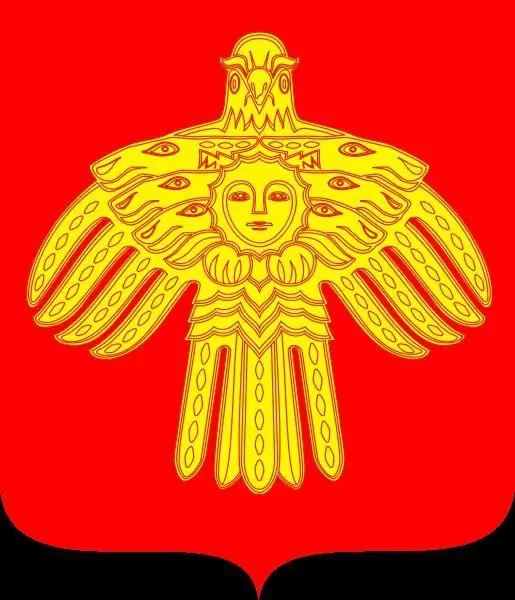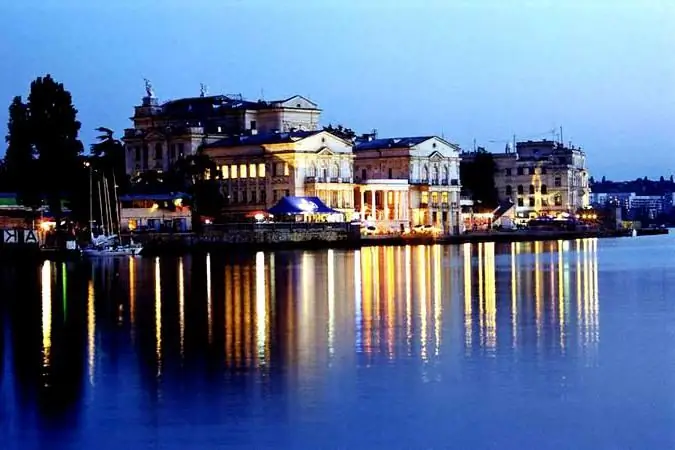- Author Harold Hamphrey [email protected].
- Public 2023-12-17 10:06.
- Last modified 2025-01-24 11:10.
In the north of the Russian Federation, west of the Ural Mountains, the Komi Republic is located. About a thousand kilometers from west to east or from south to north will have to be overcome by anyone who wants to get to know this interesting region. The Komi capital on the banks of the Sysola (river) has settled and is proud of its ancient history.
By decree of Catherine II

The relatively harsh climate has led to uneven settlement of the region. Most of the population is located in its southern part. At the confluence of the Sysola River into the Vychegda River, the Ust-Sysola churchyard arose in the 16th century, from which the Komi capital, Syktyvkar, originates.
In 1780, Empress Catherine the Second formed the Vologda vicegerency, which included nineteen counties, including Ust-Sysolsky. Accordingly, the village of Ust-Sysola was transformed into a county town with the name Ust-Sysolsk, which immediately received its own coat of arms and a master plan, suggesting the expansion of the city at the expense of adjacent settlements.
City on the Sysol River
That's right withthe Komi language translates the word Syktyvkar ("kar" - city). The first half of the name is associated with the river Sysola ("Syktyv").
The new name replaced Ust-Sysolsk after many years, in 1930, when the 150th anniversary of its city status was celebrated. In 1930, Syktyvkar was already the administrative center of the Autonomous Region of Komi (Zyryan).
The city is very conveniently located - next to the rivers Sysola and Vychegda. It is surrounded on all sides by forest, which occupies more than 70 percent of the city's area. It is 152 square kilometers. About 1,400 kilometers separate Syktyvkar from Moscow.

City develops
Another six years passed, and in December 1936 Syktyvkar received a new status - the capital of the Komi ASSR.
Industry and education began to actively develop in the city, which contributed to population growth. By 1989, more than 240,000 people lived in the Komi capital.
In Syktyvkar at that time there were about 40 large industrial enterprises, about a third of which were of all-Union significance. The timber, pulp and paper and woodworking industries accounted for more than 60 percent of all marketable products manufactured by the city. Commercial timber, lumber, plywood, chipboard, paper, non-woven materials - the capital of Komi supplied many republics of the Soviet Union with all this.
In Syktyvkar, in 1932, the State Pedagogical Institute was opened, then the Base of the USSR Academy of Sciences, whose specialists were engaged in the study of the North, and which in 1949 was alreadywas called the Komi branch of the Academy of Sciences. Syktyvkar State University opened in 1972.

Climate of Syktyvkar
Old-timers remember many months of harsh winters and a very short summer. However, global warming has also affected the climate of the capital of the Komi Republic. He became softer.
Of course, severe frosts are still not uncommon for the north-east of the European part of the Russian Federation. However, they have become not so long, on average, three weeks of severe frosts are accumulated during the winter. The rest of the winter is relatively mild, though long, lasting up to 6 months of the year.
Spring is also protracted, besides cold, uneven, snow may fall in May, and frosts will not really surprise residents even in July. If we take into account the autumn months, then there is very little time left for the summer, at most 2 months. The Komi capital cannot boast of even short-term heat. The average summer temperature is 17 degrees Celsius.
Population of Syktyvkar

Today, among the population of the city with a total number of 240 thousand people, Russians predominate - they are more than 60 percent, while the indigenous population of Komi or Komi-Zyryans is only about 30 percent.
However, this was not always the case. At the end of the 19th century, the majority of the population were Komi. Changes came in the 20th century, when political exiles, mostly Russians, were sent to this region.
Komi-Zyrians are Finno-Ugric people. He is the nativeRepublic of Komi. As of 2010, a little more than 202 thousand Komi-Zyrians lived in it (23.7% of the total population). There are representatives of this nationality in other regions of Russia, for example, the Murmansk and Sverdlovsk regions, the Nenets Autonomous Okrug. However, they are few. The total number of Komi-Zyryans throughout the Russian Federation is 228 thousand people.
Komi-Zyryans should not be confused with Komi-Permyaks, although both belong to the Finno-Ugric people.
Komi in the Perm Region
In the upper basin of the river. Kamy, in the Cis-Urals, is the Komi-Permyatsky district - until 2005 an independent subject of the Russian Federation. Then it was merged with the Perm region, resulting in the creation of the Perm region.
The capital of the Komi-Permyatsky district - the city of Kudymkar - after the merger became the administrative center of the Kudymkarsky district. It is located on the tributaries of the Kama - the rivers Inva and Kuva. It is separated from Perm by 200 kilometers.
More than half of the city's population are Komi-Permyaks. In total, about 125 thousand people of this nationality live in the Russian Federation.
Historical monuments of Syktyvkar

The capital of Komi cannot complain about the lack of places of interest for tourists.
The Church of the Ascension is one of the oldest historical sites in the city. It is also called the Ascension Cemetery Church. It was built at the expense of the richest merchant of Ust-Sysolsk Alexei Sukhanov from 1811 to 1820. It was built at the cemetery for the funeral of the dead. A memorial has now been erected on the site of the cemetery.complex.
The House of Sukhanov is over 200 years old. This is not only one of the oldest historical monuments, but also the first stone residential building. Later, it housed various institutions: schools, party school. In 2009, after reconstruction, the museum of I. Kuratov was opened in this building.
The National Gallery is located in another historical building, which was built more than 120 years ago for the Ust-Sysolsky Theological School.
The Compound of the Trinity Stefano-Ulyanovsky Monastery, the Suvorov House, the Fire Tower, the trading house of the Kuzbozhev merchants, the Cathedral of Stefan of Perm - all these are historical and architectural monuments of the city.
A unique place - Weathering Pillars
Let it be located not in Syktyvkar itself, but the capital of Komi is related to it. If only because it is from there that it is most convenient to get by helicopter to the seventh miracle of Russia, which is called the Weathering Pillars.
They are located in the Troitsko-Pechersky district of the Komi Republic, where the Pechora-Ilychsky Reserve is located. Two hundred million years ago, there were high mountains here, which gradually collapsed under the influence of wind, rain, sun and snow. Only 7 pillars of hard sericite-quartzite schist remained on the low mountain Man-pupu-ner. All of them have a bizarre shape and are between 30 and 42 meters tall.

The remains are also called Mansi blockheads, because they were objects of worship for the Mansi people. Many legends are associated with their origin. According to one of them, six giantspursued people from the Mansi tribe, who sought to leave the Ural Mountains. At the pass at the source of the Pechora River, when the giants were already overtaking the tribe, a shaman blocked their way and turned them into stone pillars. Since then, all the shamans of the Mansi tribe have drawn their magical power from this sacred tract.
True or not. But many travelers who have visited Mount Man-pupu-ner talk about the extraordinary energy of this place. However, getting there is not so easy. The choice is small: on foot or by helicopter. But the fabulousness of the place is worth the effort.
Oil Capital of Komi
In addition to the administrative center, Syktyvkar, Komi has its so-called oil capital. This is the young city of Usinsk, which is only 30 years old since it was founded in 1984.
On Usa in 1960, the first well was drilled, in which oil was found. And four years later, the construction of a settlement for an oil exploration expedition of deep drilling began there. A few years later, the Komsomol construction of an already well-maintained village was announced there, which, in turn, soon became a city. The total volume of oil produced at the fields of the Usinsk region in 1999 exceeded 200 million tons.
Today, Usinsk can rightfully be called the center of the largest oil-producing region in Komi. The main oil producing enterprises are located here: RN-Severnaya Neft, Lukoil-KOMI, Usinsk industrial company Nedra and others.
The 2010 census showed that 47 thousand people live in Usinsk.
RivalsSyktyvkar

If you get acquainted with the news of the Republic of Komi over the past ten years, you can see that sometimes passions flare up there over the capital of Komi. For example, the city of Ukhta at one time claimed this honorary "position".
Why? There were even several arguments in his favor. Ukhta is considered the educational center of the region, because USTU is located there - one of the rare universities in Russia that graduates oil and gas specialists. The convenience of transportation also speaks in favor of Ukhta: not a single settlement in Komi can compete with it.
However, no matter how events unfold, the answer to the question: “What is the capital of the Komi Republic?” - we all answer: "Syktyvkar".






